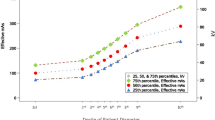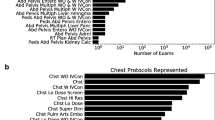Abstract
Background
It is necessary to develop a mechanism to estimate and analyze cumulative radiation risks from multiple CT exams in various clinical scenarios in children.
Objective
To identify major contributors to high cumulative CT dose estimates using actual dose-length product values collected for 5 years in children.
Materials and methods
Between August 2006 and July 2011 we reviewed 26,937 CT exams in 13,803 children. Among them, we included 931 children (median age 3.5 years, age range 0 days–15 years; M:F = 533:398) who had 5,339 CT exams. Each child underwent at least three CT scans and had accessible radiation dose reports. Dose-length product values were automatically extracted from DICOM files and we used recently updated conversion factors for age, gender, anatomical region and tube voltage to estimate CT radiation dose. We tracked the calculated CT dose estimates to obtain a 5-year cumulative value for each child. The study population was divided into three groups according to the cumulative CT dose estimates: high, ≥30 mSv; moderate, 10–30 mSv; and low, <10 mSv. We reviewed clinical data and CT protocols to identify major contributors to high and moderate cumulative CT dose estimates.
Results
Median cumulative CT dose estimate was 5.4 mSv (range 0.5–71.1 mSv), and median number of CT scans was 4 (range 3–36). High cumulative CT dose estimates were most common in children with malignant tumors (57.9%, 11/19). High frequency of CT scans was attributed to high cumulative CT dose estimates in children with ventriculoperitoneal shunt (35 in 1 child) and malignant tumors (range 18–49). Moreover, high-dose CT protocols, such as multiphase abdomen CT (median 4.7 mSv) contributed to high cumulative CT dose estimates even in children with a low number of CT scans.
Conclusion
Disease group, number of CT scans, and high-dose CT protocols are major contributors to higher cumulative CT dose estimates in children.






Similar content being viewed by others
References
Brenner DJ, Hall EJ (2007) Computed tomography — an increasing source of radiation exposure. N Engl J Med 357:2277–2284
Goske MJ, Applegate KE, Boylan J et al (2008) The ‘Image Gently’ campaign: increasing CT radiation dose awareness through a national education and awareness program. Pediatr Radiol 38:265–269
Semelka RC, Armao DM, Elias J Jr et al (2007) Imaging strategies to reduce the risk of radiation in CT studies, including selective substitution with MRI. J Magn Reson Imaging 25:900–909
Goo HW (2012) CT radiation dose optimization and estimation: an update for radiologists. Korean J Radiol 13:1–11
Neumann RD, Bluemke DA (2010) Tracking radiation exposure from diagnostic imaging devices at the NIH. J Am Coll Radiol 7:87–89
Goo HW (2005) Pediatric CT: understanding of radiation dose and optimization of imaging techniques. J Korean Radiol Soc 52:1–5
Yang DH, Goo HW (2008) Pediatric 16-slice CT protocols: radiation dose and image quality. J Korean Radiol Soc 59:333–347
Jung YY, Goo HW (2008) The optimal parameter for radiation dose in pediatric low dose abdominal CT: cross-sectional dimensions versus body weight. J Korean Radiol Soc 58:169–175
Goo HW (2011) Individualized volume CT dose index determined by cross-sectional area and mean density of the body to achieve uniform image noise of contrast-enhanced pediatric chest CT obtained at variable kV levels and with combined tube current modulation. Pediatr Radiol 41:839–847
Mettler FA Jr, Thomadsen BR, Bhargavan M et al (2008) Medical radiation exposure in the U.S. in 2006: preliminary results. Health Phys 95:502–507
Amis ES Jr, Butler PF, Applegate KE et al (2007) American College of Radiology white paper on radiation dose in medicine. J Am Coll Radiol 4:272–284
Griffey RT, Sodickson A (2009) Cumulative radiation exposure and cancer risk estimates in emergency department patients undergoing repeat or multiple CT. AJR Am J Roentgenol 192:887–892
Sodickson A, Baeyens PF, Andriole KP et al (2009) Recurrent CT, cumulative radiation exposure, and associated radiation-induced cancer risks from CT of adults. Radiology 251:175–184
Holmedal LJ, Friberg EG, Børretzen I et al (2007) Radiation doses to children with shunt-treated hydrocephalus. Pediatr Radiol 37:1209–1215
Deak PD, Smal Y, Kalender WA (2010) Multisection CT protocols: sex- and age-specific conversion factors used to determine effective dose from dose-length product. Radiology 257:158–166
Li X, Samei E, Segars WP et al (2008) Patient-specific dose estimation for pediatric chest CT. Med Phys 35:5821–5828
Gilsanz V, Perez FJ, Campbell PP et al (2009) Quantitative CT reference values for vertebral trabecular bone density in children and young adults. Radiology 250:222–227
Lemburg SP, Peters SA, Roggenland D et al (2010) Cumulative effective dose associated with radiography and CT of adolescents with spinal injuries. AJR Am J Roentgenol 195:1411–1417
Kim PK, Zhu X, Houseknecht E et al (2005) Effective radiation dose from radiologic studies in pediatric trauma patients. World J Surg 29:1557–1562
Domina JG, Dillman JR, Adler J et al (2013) Imaging trends and radiation exposure in pediatric inflammatory bowel disease at an academic children’s hospital. AJR Am J Roentgenol 201:W133–W140
Ahmed BA, Connolly BL, Shroff P et al (2010) Cumulative effective doses from radiologic procedures for pediatric oncology patients. Pediatrics 126:e851–e858
Chawla SC, Federman N, Zhang D et al (2010) Estimated cumulative radiation dose from PET/CT in children with malignancies: a 5-year retrospective review. Pediatr Radiol 40:681–686
Nievelstein RAJ, Quarles van Ufford HME, Kwee TC et al (2012) Radiation exposure and mortality risk from CT and PET imaging of patients with malignant lymphoma. Eur Radiol 22:1946–1954
Pierobon J, Webber CE, Naylager T et al (2011) Radiation doses originating from diagnostic procedures during the treatment and follow-up of children and adolescents with malignant lymphoma. J Radiol Prot 31:83–93
Lee YJ, Chung YE, Lim JS et al (2012) Cumulative radiation exposure during follow-up after curative surgery for gastric cancer. Korean J Radiol 13:144–151
O’Connell OJ, McWilliams S, McGarrigle A et al (2012) Radiologic imaging in cystic fibrosis: cumulative effective dose and changing trends over 2 decades. Chest 141:1575–1583
Ait-Ali L, Andreassi MG, Foffa I et al (2010) Cumulative patient effective dose and acute radiation-induced chromosomal DNA damage in children with congenital heart disease. Heart 96:269–274
Goo HW, Choi SH, Ghim T et al (2005) Whole-body MRI of paediatric malignant tumours: comparison with conventional oncological imaging methods. Pediatr Radiol 35:766–773
Punwani S, Taylor SA, Bainbridge A et al (2010) Pediatric and adolescent lymphoma: comparison of whole-body STIR half-Fourier RARE MR imaging with an enhanced PET/CT reference for initial staging. Radiology 255:182–190
Goo HW (2010) Whole-body MRI of neuroblastoma. Eur J Radiol 75:306–314
Goo HW (2011) Regional and whole-body imaging in pediatric oncology. Pediatr Radiol 41:S186–S194
Koral K, Blackburn T, Balley AA et al (2012) Strengthening the argument for rapid brain MR imaging: estimation of reduction in lifetime attributable risk of developing fatal cancer in children with shunted hydrocephalus by instituting a rapid brain MR imaging protocol in lieu of head CT. AJNR Am J Neuroradiol 33:1851–1854
Krishnamurthy S, Schmidt B, Tichenor MD (2013) Radiation risk due to shunted hydrocephalus and the role of MR imaging-safe programmable valves. AJNR Am J Neuroradiol 34:695–697
Choi SH, Goo HW, Yoon CH (2004) Multi-slice spiral CT of living-related liver transplantation in children: pictorial essay. Korean J Radiol 5:199–209
Chu WC, Yeung DT, Lee KH (2005) Feasibility of morphologic assessment of vascular and biliary anatomy in pediatric liver transplantation: all-in-one protocol with breath-hold magnetic resonance. J Pediatr Surg 40:1605–1611
Towbin AJ, Sullivan J, Denson LA et al (2013) CT and MR enterography in children and adolescents with inflammatory bowel disease. Radiographics 33:1843–1860
Kalra MK, Quick P, Singh S et al (2013) Whole spine CT for evaluation of scoliosis in children: feasibility of sub-milliSievert scanning protocol. Acta Radiol 54:226–230
Goo HW (2010) State-of-the-art CT imaging techniques for congenital heart disease. Korean J Radiol 11:4–18
Christner JA, Kofler JM, McCollough CH (2010) Estimating effective dose for CT using dose-length product compared with using organ doses: consequences of adopting International Commission on Radiological Protection publication 103 or dual-energy scanning. AJR Am J Roentgenol 194:881–889
Goo HW (2013) Dual-energy lung perfusion and ventilation CT in children. Pediatr Radiol 43:298–307
Li X, Zhang D, Liu B (2011) Automated extraction of radiation dose information from CT dose report images. AJR Am J Roentgenol 196:W781–W783
Sodickson A, Warden GI, Farkas CE et al (2012) Exposing exposure: automated anatomy-specific CT radiation exposure extraction for quality assurance and radiation monitoring. Radiology 264:397–405
Cook TS, Zimmerman SL, Steingall SR et al (2011) RADIANCE: an automated, enterprise-wide solution for archiving and reporting CT radiation dose estimates. Radiographics 31:1833–1846
Dave JK, Gingold EL (2013) Extraction of CT dose information from DICOM metadata: automated Matlab-based approach. AJR Am J Roentgenol 200:142–145
Martin CJ (2007) Effective dose: how should it be applied to medical exposure? Br J Radiol 80:639–647
Pearce MS, Salotti JA, Little MP et al (2012) Radiation exposure from CT scans in childhood and subsequent risk of leukaemia and brain tumours: a retrospective cohort study. Lancet 380:499–505
Mathews JD, Forsythe AV, Brady Z et al (2013) Cancer risk in 680,000 people exposed to computed tomography scans in childhood or adolescence: data linkage study of 11 million Australians. BMJ 346:f2360
Strauss KJ, Goske MJ (2011) Estimated pediatric radiation dose during CT. Pediatr Radiol 41:S472–S482
Conflicts of interest
None
Author information
Authors and Affiliations
Corresponding author
Rights and permissions
About this article
Cite this article
Lee, E., Goo, H.W. & Lee, JY. Age- and gender-specific estimates of cumulative CT dose over 5 years using real radiation dose tracking data in children. Pediatr Radiol 45, 1282–1292 (2015). https://doi.org/10.1007/s00247-015-3331-y
Received:
Revised:
Accepted:
Published:
Issue Date:
DOI: https://doi.org/10.1007/s00247-015-3331-y




